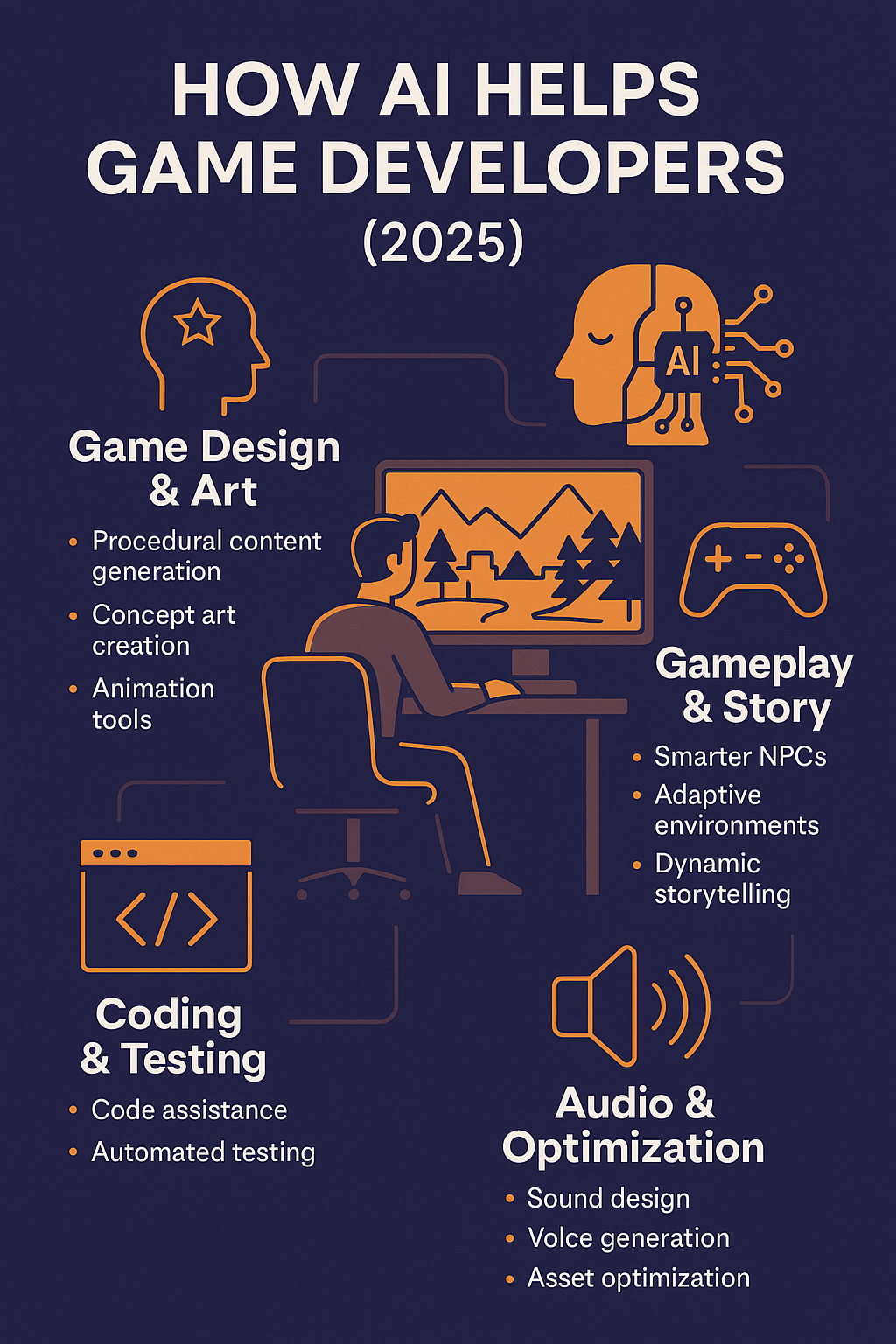
Artificial Intelligence, or AI for short, has evolved from a strictly futuristic concept associated with games to a very practical and incredibly potent tool that now basically transforms the way developers create, refine, and publish their games. You’re either a solo developer on a small-scale project or part of a massive AAA studio with enormous budgets, and AI brings creative solutions that dramatically boost productivity, enhance creative potential, and ultimately enhance the overall experiences that users have playing games.
In this comprehensive guide, we will explore and cover in detail the many ways artificial intelligence assists and helps developers at every stage of the whole game development process, from the idea to its completion.
Boosting Creativity and Speed: AI in Game Design, Art & Animation
One of the most important challenges that developers have to deal with in their job is the challenging task of creating a lot of high-quality content under pressure of working under tight schedules. In this sense, artificial intelligence is an excellent creative partner, playing an important role in accelerating several processes like concept art design, level design creation, and character animation creation.
For instance, cutting-edge technology such as MidJourney, DALL·E, and Leonardo.ai possesses the incredible capacity to generate spectacular and stunning concept art from plain and simple text inputs. Such capability provides developers with a visually engaging starting point within minutes, significantly accelerating the creative process. Similarly, sophisticated procedural generation algorithms can generate elaborate and complex worlds, diverse landscapes, and elaborate dungeons automatically, in effect reducing the effort input developers need to make while, at the same time, providing a beautiful variety to the output.
There are sophisticated, AI-based software such as Cascadeur and RADiCAL within the animation industry that greatly help developers in generating character movements that are immensely natural and realistic in appearance. The sophisticated software has the amazing ability to simulate physics-based animations, which not only raises the overall realism level of the animations but also reduces production costs that would otherwise be spent on conventional, costly motion capture systems.
Simplifying Development: AI as a Coding and Testing Assistant
Game code is labor-intensive to code and keep updated. Tools such as GitHub Copilot and ChatGPT are indispensable for developers nowadays, providing real-time code suggestions, debugging advice, and optimization tips. This not just accelerates development but also keeps the codebases neat and optimized.
In addition to coding, AI is also crucial in automated testing. Through its ability to mimic thousands of game scenario possibilities, AI-based testing software is able to identify bugs, performance problems, and gameplay imbalances more quickly than manual QA solutions. This results in more stable releases and an improved player experience.
Creating Immersive Experiences: Smarter NPCs, Adaptive Gameplay & Storytelling
AI animates games with the capability to make intelligent NPC behavior, dynamic worlds, and responsive game systems possible. In contrast to traditional scripted AI, new methods give NPCs the capability to learn from the player, change tactics mid-stream, and act unpredictably so that each play is different.
Storytelling technology using AI can generate complex branching stories and support the personalization of the narrative on the basis of the many choices the players take throughout the game. The technology greatly increases the extent to which the players are invested in the game and can experience a real sense of agency and control of the vast game universe they are participating in.
In open-world games, AI controls complex ecosystems, from dynamic weather, crowd simulation, to even virtual economies, in order to sustain a living, breathing world which responds to players’ actions.
Enhancing Audio & Visuals: AI in Sound Design, Voice Generation & Optimization
Artificial Intelligence, or AI, is initiating a profound revolution in the domains of game audio as well as visual realism. With the help of AI-driven sound design assets, game designers are now able to create highly dynamic soundscapes that respond intelligently in real-time to different gameplay scenarios. This revolution increases the quality of the gaming experience by introducing multiple layers of immersion, all while doing away with the tedium of manual editing that was previously necessary.
For voice-overs, other advanced platforms like ElevenLabs and Replica Studios give developers the ability to synthesize very realistic character voices from text inputs. This feature greatly simplifies the prototyping of dialogue to ensure that creators are able to test out spoken lines more efficiently. The platforms also offer the option of replacing minor voice-acting roles without additional costs, thus making it easier to follow a more cost-efficient method of audio production in productions.
AI also enables visual optimization. Technologies like NVIDIA DLSS and Topaz Gigapixel AI up sample textures, improve 3D models, and optimize assets to run on a range of hardware so that there’s silky smooth performance on PCs, consoles, and mobile.
Beyond Development: AI in Player Support, Analytics & Live Ops
AI’s impact doesn’t stop after development. Post-launch, AI assists in managing player communities, moderating content, and providing automated customer support through intelligent chatbots.
In live-service games, AI analyzes player behavior, predicting trends in retention, monetization, and engagement. This data-driven insight helps developers plan content updates, balance patches, and in-game events more effectively.
AI-driven personalization systems can also recommend tutorials, items, and challenges tailored to each player, increasing satisfaction and long-term engagement.
Conclusion: AI — The Developer’s Silent Partner
For developers, AI is not about replacing human creativity but enhancing it. From automating tedious tasks to enabling features once thought impossible, AI has become an indispensable part of modern game development.
In 2025 and beyond, the developers who learn to collaborate with AI tools will build better games, faster and smarter.
👉 Final Tip:
If you’re a developer aiming to stay competitive, now is the time to explore AI-powered workflows and integrate them into your game development pipeline.